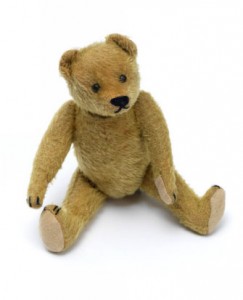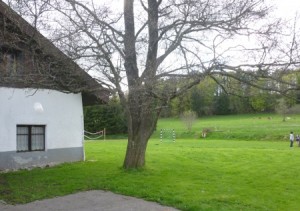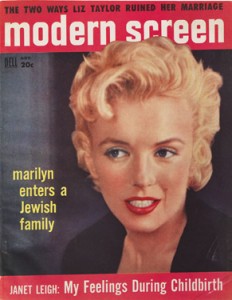
Teddy bear that belonged to Ilse Jacobson (1920-2007), textile, straw, glass, ca. 1920 to 1930, in our online collection
56,250. This is the number that comes up when I search our collection’s database for its complete holdings. 56,250 data sets describing, for the most part, individual objects, and occasionally entire mixed lots. You can now see 6,300 of these objects online. Releasing this information to the public provokes mixed feelings on the part of museum staff: we have a lot to say about many of these objects. Many of them don’t speak for themselves. You can’t tell, for instance, that this teddy bear belonged to a child emigrating from Germany. The meaning of many documents and photographs lies likewise to a large extent in their biographical or political history. They require sufficient detail and well-chosen catchwords to help visitors find other objects related to the same topic.
With this project, we have to proceed pragmatically. 15-30 minutes of working time per object is a lot if you have to inventory a mixed lot with 250 units. We verify everything, including things that occur to us as we’re working. We are aware that there’s more to write about – and there would be more to correct, – if we had the time for more thorough research. Yet we can only make forays into the library or even into the archive for special projects or particularly important objects. And so we rely to a great extent on digital sources. → continue reading

Youth hostel in alpine serenity
What’s the newest of the new in Jewish youth culture? To find out, I visited a machane, a Jewish summer camp, which congregated Europeans under the age of eighteen in a remote village in the Alps. Hoping to scout future Jewish ideas, themes, and memes, I had my eyes and ears open for interesting fashions, cool music, new media, games, slang, and food.
My quest was triggered by a slew of innovations brought about by the current generation. Deviators have exchanged their traditional tallitot (prayer shawls) for colorful ones with lilies and rainbows. Others have produced trip hop versions of Jewish songs, “Matzah raps,” and uploaded parodies of Biblical stories onto youtube. → continue reading
Why a particular subject captures the interest of the public at a given time is not always immediately apparent. Conversion, for instance, has become the topic of conferences, lectures and exhibits in German-speaking Europe without any notable change in its social significance nor religious practice.

Picture in the current special exhibition “The Whole Truth” accompanying the question: Jew or non-Jew? Marilyn Monroe on the cover of the Modern Screen Magazine, November 1956
© Jewish Museum Berlin, photo: Jens Ziehe
The number of converts to Judaism is invariably small. According to the data collected by the Zentralwohlfahrtsstelle der Juden in Deutschland, on average 64 conversions are carried out yearly in the various German-Jewish communities, and since the year 2000, the number has remained fairly stable. Nor has the size of the Jewish communities varied much. For over a decade, the number of members has stabilized at around 105.000. In relation to the size of the community, the total number of converts since 1990, 1.366, makes up under one percent of the Jewish community. The number of Jews leaving the communities is slightly higher, around one hundred a year, yet the number is not particularly meaningful, because it includes people who leave for all sorts of reasons, including financial. By all accounts, today’s Jewish converts are a minute and exotic minority.
Yet the topic is currently being discussed with much enthusiasm. → continue reading


